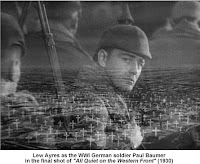Not Rated
This film is now known as one of the greatest anti-war films of all time. It is based on a novel about a group of German school boys who proudly go to war (WWI, the Great War) to defend and protect their country. They quickly become disillusioned and see war for its reality: fear, danger, and death. After Hitler’s rise to power, this film was banned in Germany because of its grim outlook on war.
The boys were so green going into this war, it was sad to see the harsh reality set in for them. As they initially settled into their bunks, they excitedly took turns sharing what area of training they desired: cavalry, bayonet drill, infantry, etc. Shortly after that, they play a prank on a higher-ranking officer, the mailman they knew from home. I can’t even imagine that would fly in today’s day and age. Not long after that, they literally start going crazy in the bunker from the sounds of the guns and bombs above. To be honest, there was a moment I was about to go crazy myself just from the incessant background sound effects, but I will bite my tongue since I find myself in the comfort of my home while there are soldiers out there now selflessly defending our country. The film ends up highlighting Paul Baumer, one of the boys, who I think got snubbed an Oscar nomination for Best Actor (or Supporting Actor?). He gives us a more personal view into the challenging life of a young soldier.
There were a couple of scenes that showed the men learning to march which had me questioning its history and current relevance. To me, it seems that marching as a collective group served an obvious purpose during wars like the Civil War when armies literally squared off and/or attacked on foot on large battlefields. I questioned the importance of it now when wars are fought more from a distance or with small groupings of soldiers. I sought education from my cousin-in-law (my cousin’s husband) who is currently in the Army Reserves). He explained that there is platoon-size (20+) and company-size (100+) marching and formation which is basically for ceremony and to instill discipline. It is important for a group that size to look uniform (no pun intended) and in sync at all times. But there is also field march, or tactical march, which is used more in the field. There you’ll see a platoon-sized group staggered AND separated on either side of a road (or by at least 10 feet); this is for protection against roadside bombs or ambushes. [Thank you Justin… We love you and are praying for you.]

This was only the third movie to win Best Picture, so keep in mind, the visual effects aren’t amazing. For example, soldiers sometimes fell down injured or dead before the bomb even exploded near then. Or some reacted to a bayonet stabbing when it wasn’t even close. That’s ok though; I overlooked it. I thought the final scene was well done though. It showed the boys marching away, each taking his turn to look back directly into the camera, while the imposed soft background showed a plain of white crosses.
Overall, I was generally entertained by this film. I even caught myself smiling at some of the dialogue. But on a more serious note, I was impacted by the boys’ reactions to war. This film was up against “The Big House”, “Disraeli”, “The Divorcee”, and “The Love Parade”, none of which I’ve seen. It also won for Best Director, winning two of its four nominations.
INTERESTING LINES:
After having an unusually large dinner, the group of boys starts wondering aloud…
“Well, how DO they start a war?”
“Well, one country offends another”
“You mean there’s a mountain over in Germany gets mad at a field over in France?”
“Well, stupid, one people offends another”
“Oh, well, if that’s it, I shouldn’t be here at all. I don’t feel offended”
…
“Well it must be doing somebody some good”
I thought this dialogue was so innocent. It shows how clueless these boys were in their position in the war. They just knew it was an honor to fight. Sadly, because of my lack of involvement in politics, I can relate to their line of thinking sometimes.
INTERESTING SCENE:
There is one scene where some older gentlemen “back home” are talking about the war and complaining about the food at their current establishment in the presence of Paul, who was on leave at the time. One nods to him and says, “After all, you do at least get decent food out there. Naturally, it’s worse here. Naturally. But ‘the best for our soldiers all the time’. That’s our motto.” Paul remains silent; only the audience knows what his eating routine and menu was like when he was in active duty. He is even so pompous as to accuse and offend the soldier of not knowing anything about the war. Of course he explains Paul knows the “details” but not “how it relates to the whole”.
This leads me to my…
LESSONS LEARNED:
Don’t pretend to know what goes on “over there,” unless of course, you have a loved one telling you specifics.
Pray for our brave soldiers, that they have the strength to continue fighting for and defending our country, that they know how much they are loved by the family and friends who miss them dearly, and that they return safely to us when their time comes. And remember to pray for our veterans and the deceased. They have helped make our country what it is today.


















